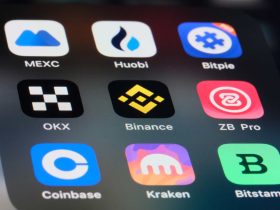Where have all the weirdos gone? Not two years ago in a cover story on the state of finance, I opened with a cowboy in his underpants serenading a Times Square duo in matching onesies about a holographic worm. He had been commissioned to raise interest in a particular nonfungible token. If you don’t know what those are, they’re unique, tradable, blockchain identifiers—contrived digital scarcity, basically. If you’re wondering why someone would buy such a thing, it’s because a) prices for some of them were shooting higher at the time, and b) the people pitching them used cartoon ape faces and such to make them more personable. And if you’re thinking that sounds crazier than cryptocoins, you get it.
I’m pretty sure the cowboy is still around—he’s a Midtown Manhattan fixture. But I can’t remember a recent mention of NFTs.
Crypto still trades, of course, but its collective value has fallen from $3 trillion to a little over $1 trillion, or from roughly the money supply of the United Kingdom to that of Canada. Meme stock action isn’t what it used to be. Sure, chat room traders will occasionally take a broken growth stock like
Carvana
(ticker: CVNA) for a joy ride. But they used to have more of a sense of humor, running up shares of the wrong company named Zoom, for example, or piling into a shell company linked to the former Blockbuster video rental chain.
Higher interest rates have washed away much of the wackiness. Two years ago, the Federal Reserve was targeting a core interest rate of 0% to 0.25%. Now it’s at 5.25% to 5.5%. Suddenly, it costs real money to convert interest-earning deposits into something speculative. Meanwhile, prices for ordinary investments are as agreeable as they’ve been in years, with the possible exception of a handful of U.S. stocks. Take a look.
A plain-vanilla U.S. bond index fund like the
Vanguard Total Bond Market
exchange-traded fund (BND) pays 4.7%, or a point more than the latest year-over-year reading on inflation. Policy makers this past week left rates unchanged but held open the possibility of another hike, and indicated that they expect rates to remain above prepandemic levels for years longer. Charles Schwab fixed-income strategist Kathy Jones points out that Treasury yields tend to peak before the last rate hike of the cycle. She sees now as a good time to lock in bond yields before they fall.
Robert Tipp, the chief investment strategist at PGIM Fixed Income, has advice for tactical bond buyers. The middle of the yield curve appears to have priced in expectations of future rate declines more fully than the rest of the curve, he says. If interest rates don’t fall, these bonds could be subject to “roll-ups.” That’s where prices gently decline as bonds age to match the higher yields that are available now on shorter issues. To reduce that roll-up potential, Tipp recommends a barbell approach focused on bonds shorter than two years and longer than 10.
But less-tactical investors who simply buy a broad basket of quality bonds are likely to be happy enough with their results, says Tipp. “Yield is destiny,” he says, meaning that starting yields are a pretty good indication of future results. Many investors have too little in bonds now, he says, either because they ditched them when yields were ultralow, and they haven’t returned, or simply because stocks have sharply outperformed bonds of late.
Gabriela Santos, global market strategist at J.P. Morgan Asset Management, says this is an excellent time for U.S. stock investors to shift money to overseas markets. Prices are attractive. The
iShares MSCI Eurozone
ETF (EZU) traded recently at 12 times this year’s projected earnings, and the
iShares MSCI Japan
ETF (EWJ), at 16 times, versus 20 times for the
S&P 500
index of U.S. stocks. The U.S. dollar, following 14 years of strengthening, could give up ground to the euro and the yen, adding to overseas returns, says Santos. There has also been a shift in corporate behavior abroad. “Europe and Japan have discovered the secret sauce of buybacks as something that not just mechanically improves earnings per share, but also something that at the end of the day is rewarded by shareholders,” says Santos.
Even U.S. stocks could continue shining. This past week, BofA Research predicted a further 4% gain from here for the S&P 500 by year’s end. Higher yields aren’t necessarily an impediment; the bank points out that from the mid-1980s to 2008, real rates were more than a point higher than now, and stocks returned 15% a year. Also, companies, unlike bonds, can always make changes.
Meta Platforms
(META) this year announced cost cuts and stock buybacks, and projections for its earnings per share have climbed from about $8 to over $13.
What makes the S&P 500 relatively expensive, of course, are puffed-up valuations for seven technology companies with outsize index weightings. BofA is particularly bullish on the equal-weight version of the index, like the one underpinning the
Invesco S&P 500 Equal Weight
ETF (RSP). It recently traded below 16 times this year’s projected earnings.
The valuation gap between the equal-weight index and the top seven stocks in the regular S&P 500 is the widest since the late-1990s dot-com stock bubble, says BofA. Plus, the second quarter seems to have marked a trough in the current earnings cycle, and the recovery part of the cycle, which we might be in now, tends to favor the value tilt of the equal-weight index.
Somewhere in there is a mix of assets that can perform for the next decade even without meme status or an underdressed cowboy crooning to raise exposure. Although, if you want to hedge, I’m sure he’d be willing to work up an equal-weight indexing diddy for a reasonable fee.
Write to Jack Hough at jack.hough@barrons.com. Follow him on Twitter and subscribe to his Barron’s Streetwise podcast.
Read the full article here













Leave a Reply